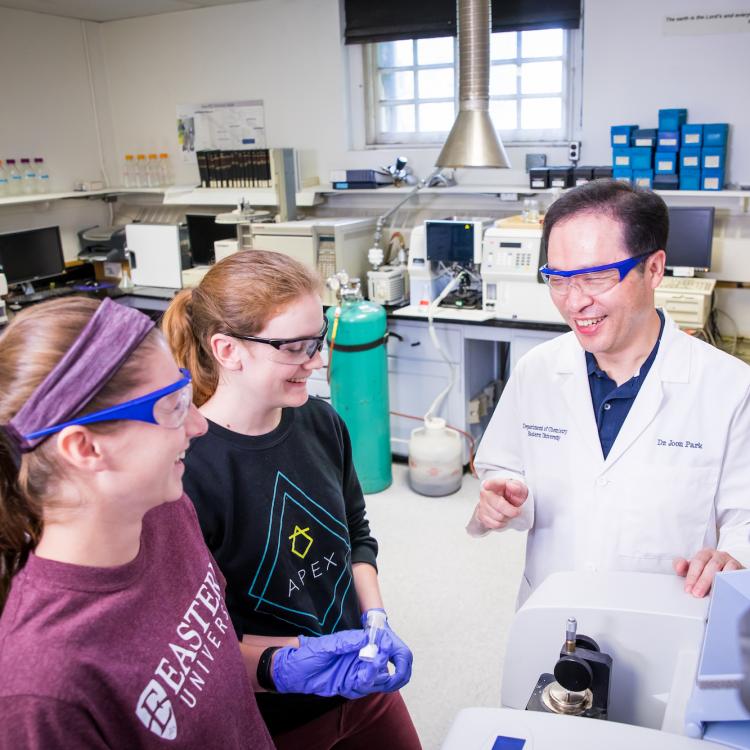My research interests are focused on the engineering of bio-inspired molecules and molecular assemblies using organic chemistry. Biological phenomena, concepts, and structures have recently provided material scientists with great inspiration for the development of novel materials having attractive structures and properties. Organic chemistry has played a critical role in the development of bio-inspired materials and the resulting materials have been widely used in a variety of practical applications such as biological sensing and biomedical diagnostics. I will develop strategies to prepare novel bio-inspired organic materials and seek their applications in bionanotechnology. Below I briefly introduce three representative examples of research projects that I pursue:
1) Liquid Crystal-Based Screening of Kinase Activity
Detection of biomolecules is a critical step in a variety of practical biotechnologies including biomedical diagnostics and biological sensing. To develop surface-based biosensors, the biochemical event occurring at an interface should be converted into a measurable output signal to be detected. Past studies showed that liquid crystals can be effectively used as a signal transducer to amplify and report chemical and biochemical events on a surface. I will develop a novel strategy to incorporate peptide substrates into an aqueous-liquid crystal interface. The peptide-modified aqueous-liquid crystal interface will be used to visualize kinase activities.
2) Multifunctional Dendrimer-Based Nanodevice for Diagnostic Imaging
Dendrimers are highly branched, highly functionalized polymers with a well-defined symmetrical structure. Poly(amidoamine) (PAMAM) dendrimers consisting of beta-alanine subunits are often called as "artificial proteins" due to their similarities in sizes, shapes, and structures. I will develop a novel method to prepare a covalently conjugated dendrimer-nanoparticle nanocomposite which can be used for targeted diagnostic magnetic resonanace imaging (MRI). The method consists of the functionalization of PAMAM dendrimers and the subsequent covalent conjugation with nanoparticles prepared in a separate step.
3) Nanoparticle-Based Detection of Proteases
Nanometer-scale metal particles have been enjoying a great deal of interest from researchers due to their potential applications in electronics, catalysis, molecular recognition, and chemical and biological sensing. The size-dependent electronic, magnetic, and optical properties of metal nanoparticles (quantum size effect) have been utilized in the field of biomolecular diagnostics and detections. I will develop a simple assay system for proteases using gold nanoparticles immobilized at peptide-modified interfaces. To prepare the system, peptide substrates that can be hydrolyzed by a protease will be immobilized to polymer or metal surface. Subsequently, gold nanoparticles will be conjugated to the immobilized peptide substrates. A merit of this approach is that the presence of a protease can be visually monitored with bare eyes.
Research Publications
"Analysis of the Wettability of Partially Fluorinated Polymers Reveals the Surprisingly Strong Polar or Acid-Base? Character of Poly(vinylidene Fluoride)", Sangwha Lee; Joon-Seo Park; T. Randall Lee, Chemical Engineering Journal, Manuscript in preparation.
"A Sensing Device Using Liquid Crystal in a Micropillar Array Supporting Structure", Daming Cheng; Sudheer S. Sridharamurthy; Jacob T. Hunter; Joon-Seo Park; Nicholas L. Abbott; Hongrui Jiang, Journal of Microelectromechanical Systems, 2009, 18, 973-982.
"Ordering Transitions in Thermotropic Liquid Crystals Induced by the Interfacial Assembly and Enzymatic Processing of Oligopeptide-Amphiphiles", Joon-SeoPark; Nicholas L. Abbott, Advanced Materials, 2008, 20, 1185-1190.
"Preparation, Characterization, and Chemical Stability of Gold Nanoparticles Coated with Mono-, Bis-, and Tris-Chelating Alkanethiols", La-ongnuanSrisombat; Joon-SeoPark; Shishan Zhang; T. Randall Lee, Langmuir, 2008, 24, 7750-7754.
"The Wettability of Fluoropolymer Surfaces: Influence of Surface Dipoles", Sangwha Lee; Joon-SeoPark; T. Randall Lee, Langmuir, 2008, 24, 4817-4826.
"Coupling of the Plasmon Resonance of Chemically Functionalized Gold Nanoparticles to Local Order in Thermotropic Liquid Crystals", Gary M. Koenig, Jr.; Maria-Victoria Meli; Joon-Seo Park; Juan J. de Pablo; Nicholas L. Abbott, Chemistry of Materials 2007, 19, 1053-1061.
"Formation of Oligopeptide-Based Polymeric Membranes at Interfaces Between Aqueous Phases and Thermotropic Liquid Crystals", Joon-Seo Park; Sarah Teren; William H. Tepp; David J. Beebe; Eric A. Johnson; Nicholas L. Abbott, Chemistry of Materials 2006, 18, 6147-6151.
"Influence of 4-Cyano-4’-biphenylcarboxylic Acid on the Orientational Behavior of Cyanobiphenyl Liquid Crystal", Joon-Seo Park; Chang-Hyun Jang; Matthew L. Tingey; Aaron M. Lowe; Nicholas L. Abbott, Journal of Colloid and Interface Science 2006, 304, 459-473.
"Synthesis of Tetraoctylammonium-Protected Gold Nanoparticles with Improved Stability", Steven R. Isaacs; Erin C. Cutler; Joon-Seo Park; T. Randall Lee; Young-Seok Shon, Langmuir 2005, 21, 5689-5692.
"Systematic Control of the Packing Density of Alkyl Chains in Self-Assembled Monolayers on Gold Generated from Chelating Alkanethiols", Joon-Seo Park; Andy Nguyen Vo; David Barriet; Young-Seok Shon; T. Randall Lee, Langmuir 2005, 21, 2902-2911.
"Synthesis and Ring-Opening Metathesis Polymerization (ROMP) of Aryl-Substituted 1,1’-(1,3-Butadienylene)ferrocenes", Richard W. Heo; Joon-SeoPark; T. Randall Lee, Macromolecules 2005, 38, 2564-2573.
"ROMP of t-Butyl-Substituted Ferrocenophanes Affords Soluble Conjugated Polymers that Contain Ferrocene Moieties in the Backbone", Richard W. Heo; Joon-Seo Park; Jason T. Goodson; Gil C. Claudio; Mitsuru Takenaga; Thomas A. Albright; T. Randall Lee, Tetrahedron 2004, 60, 7225-7235.
"Loosely Packed Self-Assembled Monolayers on Gold Generated from 2-Alkyl-2-methylpropane-1,3-dithiols", Joon-SeoPark; Aaron C. Smith; T. Randall Lee, Langmuir 2004, 20, 5829-5836.
"Stability of Aliphatic Dithiocarboxylic Acid Self-Assembled Monolayers on Gold", Tai-Chou Lee; Donna J. Hounihan; Ramon Colorado, Jr.; Joon-Seo Park; T. Randall Lee, Journal of Physical Chemistry B 2004, 108, 2648-2653.
"Carbon-Bridged Ferrocenophanes", Joon-SeoPark; T. Randall Lee, In Modern Cyclophane Chemistry, Henning Hopf and Rolf Gleiter Eds.; Wiley: Weinheim, 2004; pp 131-157.
"Synthesis, Characterization, and Reactivity of ReOMe2(bipy)X Complexes", June-Ho Jung; Joon-SeoPark; David M. Hoffman; T. Randall Lee, Polyhedron 2001, 20, 2129-2136.
"Determination of Stability Constants Using Electrochemical Methods for Complex Formation of Platinum and Palladium with Polyelectrolytes", Joon Seo Park; Koo Soon Chung, Analytical Science & Technology 1995, 8, 691-698.
Patents
"Device and Methods for Liquid Crystal-Based Bioagent Detection", N. L. Abbott, J.-S. Park, S. Teren, D. J. Beebe, E. A. Johnson, US2007231832 (U.S.A.), WO2007111681 (PCT).
"Cholesterol Biosynthesis Inhibitors", J. H. Kim, T. N. Jhong, Y. K. Paik, J. S. Park, E. D. Kim, Y. S. Lee, S. U. Kim, US6255317 (U.S.A.).
"13, 13α-Didehydroberberine Derivatives", J. H. Kim, T. N. Jhong, Y. K. Paik, J. S. Park, E. D. Kim, Y. S. Lee, S. U. Kim, US6239139 (U.S.A.).
"Aryl Benzoyl Urea Derivative and Pesticidal Composition Comprising the Same", J. H. Kim, J. W. Woo, Y. W. Shin, J. N. Heo, E. D. Kim, J. S. Park, US6051737 (U.S.A.), WO9724321 (PCT), JP11501332 (Japan), EP939753 (Europe), CN1205686 (China), IN185380 (India), BR9612312 (Brazil), KR1001945350000 (Korea, Patent Number).
"Pharmaceutical Composition Comprising 5,6-Dihydrodibenzo[a,g]quinolizinium Derivatives and the Salts Thereof", J. H. Kim, T. N. Jhong, Y. K. Paik, J. S. Park, E. D. Kim, Y. S. Lee, S. U. Kim, US6030979 (U.S.A.), WO2000037468 (PCT), JP2000191662 (Japan), EP1140930 (Europe), CA2355469 (Canada), RU2223962 (Russia), AU9920776, AU777377 (Australia), BR9916431 (Brazil).
"Antifungal Formulation Comprising Protoberberine Derivatives and Salts Thereof", J. H. Kim, T. N. Jhong, Y. K. Paik, J. S. Park, E. D. Kim, Y. S. Lee, S. U. Kim, US6030978 (U.S.A.), WO9955704 (PCT), JP11302282 (Japan), EP1073655 (Europe), CN1134435 (China), CA2329434 (Canada), RU2204559 (Russia), AT264325 (Austria), AU9897642, AU758757 (Australia), BR9815828 (Brazil), KR1002588490000 (Korea, Patent Number).
"Dibenzo-[a.g]quinolizinium Derivatives and the Salts Thereof", J. H. Kim, T. N. Jhong, Y. K. Paik, J. S. Park, E. D. Kim, Y. S. Lee, S. U. Kim, US6028197 (U.S.A.), WO2000037468 (PCT), JP2000191662 (Japan), EP1140930 (Europe), CA2355469 (Canada), RU2223962 (Russia), AU9920776, AU777377 (Australia), BR9916431 (Brazil).
"2-Chloro-3,5-bis(trifluoromethyl)phenyl Benzoyl Urea Derivative and Process for Preparing the Same", J. H. Kim, Y. W. Shin, J. N. Heo, E. D. Kim, J. S. Park, H. S. Song, US6022882 (U.S.A.), WO9800394 (PCT), JP51482, JP2000514782 (Japan), EP912502 (Europe), CN1077101,CN1225626 (China), IN186299 (India), AT198738 (Austria), ES2153202 (Spain), KR1001945340000 (Korea, Patent Number).
"Pharmaceutically Available Protoberberine Salts Derivatives, and Protoberberine Derivatives and Salts Thereof", J. H. Kim, T. N. Jhong, Y. K. Paik, J. S. Park, E. D. Kim, Y. S. Lee, S. U. Kim, US6008356 (U.S.A.), WO9955704 (PCT), JP11302282 (Japan), EP1073655 (Europe), CN1134435 (China), CA2329434 (Canada), RU2204559 (Russia), AT264325 (Austria), AU9897642, AU758757 (Australia), BR9815828 (Brazil), KR1002588490000 (Korea, Patent Number).







